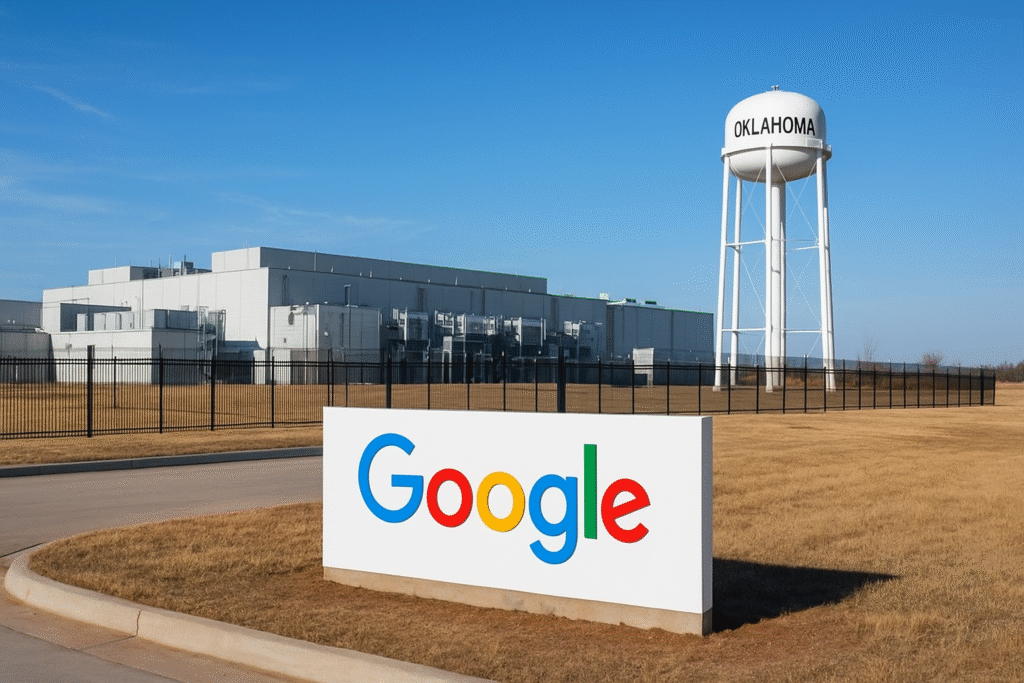Google AI expansion in Oklahoma is set to reshape the state’s technological and economic landscape. Alphabet’s tech giant has pledged an additional $9 billion investment over the next two years to boost its cloud and artificial intelligence capabilities, building a massive new data center campus in Stillwater and expanding its existing Pryor facility.
This move isn’t just about hardware it’s about preparing Oklahoma for the future of AI, cloud computing, and the workforce that will power it. The timing of the Google AI expansion in Oklahoma is no coincidence.
The AI race among tech giants such as Amazon, Microsoft, and Meta is intensifying, with each company pouring billions into infrastructure to handle the explosion of AI driven services. Google’s decision to center a major portion of this growth in Oklahoma stems from several strategic advantages.
Low cost, renewable energy availability for powering large scale data centers. Geographic stability, offering minimal natural disaster risk compared to coastal hubs. A growing talent pool, thanks to partnerships with local universities and training programs.
AI is no longer an optional feature it’s the foundation of future digital services, said Eric Schmidt, former Google CEO. By investing in Oklahoma, Google is securing both the technology and the talent pipeline it needs for the next decade.
The Economic Ripple Effect
The Google AI expansion in Oklahoma is expected to generate thousands of jobs both directly in data center operations and indirectly through construction, supply chain, and local business growth.
According to a case study from the Economic Impact Research Group, similar investments in tech infrastructure can produce a local GDP increase of up to 1.5% annually. In Pryor, where Google has already operated a large facility since 2011, property values have risen, and small businesses have reported a surge in demand for services ranging from catering to IT support.
In Council Bluffs, Iowa, Google’s previous $5 billion data center investment not only created permanent jobs but also funded STEM programs in local schools, leading to a 23% increase in computer science enrollment. Experts believe Oklahoma could experience similar benefits.
Building a Future Ready Workforce
A key component of this $9 billion commitment is workforce development. Google plans to roll out AI and cloud training programs in partnership with Oklahoma State University and regional technical colleges.
This initiative mirrors the success of Google’s Grow with Google program, which has already trained over 11 million Americans in digital skills. According to Sundar Pichai, Google’s CEO, The future of AI is not just in the machines it’s in the people who create, manage, and innovate with them.
Sarah Thomas, a software engineer who relocated to Oklahoma after Google’s Pryor expansion, described the move as life changing. I never thought I’d be working on cutting edge AI projects from a small city in Oklahoma. It’s proof that you don’t have to be in Silicon Valley to be part of something big.
Data Centers as the Backbone of AI
For AI models to work, they need immense computing power, lightning fast networking, and secure data storage functions that large scale data centers provide.
The Stillwater campus will house hyperscale server farms, specialized AI accelerators, and high efficiency cooling systems powered partly by renewable energy. Google is also incorporating liquid cooling technology to handle the increasing heat generated by AI training workloads.
Gartner predicts that global AI workloads will grow 700% by 2030, with data center capacity becoming the critical bottleneck. By expanding early, Google is positioning itself to meet demand before shortages hit.
A common criticism of large tech expansions is the environmental footprint, especially energy use. Google counters this by committing to run its Oklahoma facilities entirely on renewable energy, drawing from wind farms in the state.
This approach is consistent with Google’s broader goal of achieving 24/7 carbon free energy by 2030. In Pryor, renewable sourcing has already cut operational emissions by 80%, setting a precedent for Stillwater.
Dr. Michael Anderson, a professor of technology economics at the University of Oklahoma, believes the state is an untapped goldmine for tech investment. We have the land, the energy resources, and the will to embrace innovation. Google’s AI expansion validates Oklahoma’s position on the national tech map.
Meanwhile, industry analyst Laura Chen highlights the competitive angle, Every dollar Google spends here is also a dollar that keeps them ahead of Microsoft and Amazon in the AI race. Location matters less than latency, energy cost, and talent and Oklahoma scores high on all three.
Long Term Impact: More Than Just Servers
The Google AI expansion in Oklahoma could inspire other technology companies to view the state as a viable hub for advanced computing. If successful, Oklahoma could transition from an energy driven economy to a tech energy hybrid economy, creating resilience against market downturns in oil and gas.
Local officials are already discussing incentives for startups and AI focused businesses to cluster around Google’s facilities, potentially creating an AI corridor similar to Austin’s tech boom.
A Defining Moment for Oklahoma’s Tech Future
The Google AI expansion in Oklahoma is more than an infrastructure project it’s a statement about the future of technology and where it can thrive. With $9 billion on the table, thousands of jobs in the pipeline, and a commitment to clean energy and education.
Google is laying the foundation for a new era in the state’s history. As AI becomes an inseparable part of everyday life, Oklahoma won’t just be watching the future happen it will be helping to build it.

